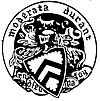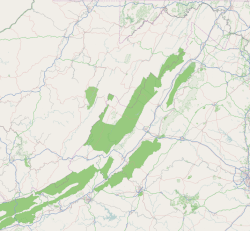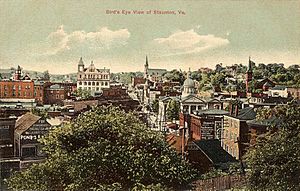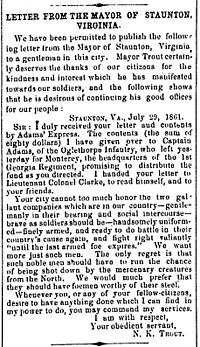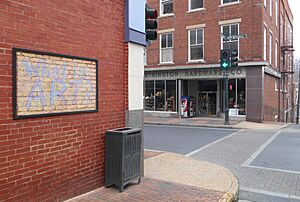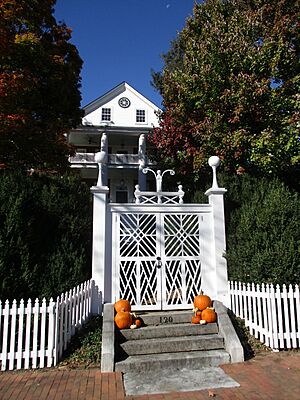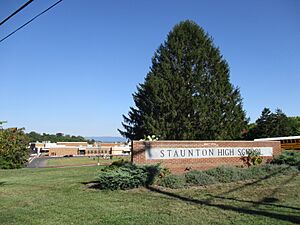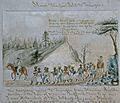Staunton, Virginia facts for kids
Quick facts for kids
Staunton
|
|||
|---|---|---|---|
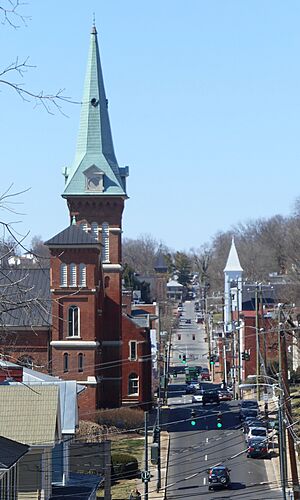
Frederick Street
|
|||
|
|||
| Nickname(s):
Queen City of the Shenandoah Valley
|
|||
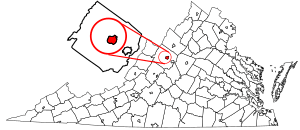
Location of Staunton in the Commonwealth of Virginia
|
|||
| Country | United States | ||
| State | Virginia | ||
| County | None (Independent city) | ||
| Incorporated | 1801 | ||
| Government | |||
| • Type | Council-manager government | ||
| Area | |||
| • Total | 19.98 sq mi (51.74 km2) | ||
| • Land | 19.92 sq mi (51.59 km2) | ||
| • Water | 0.06 sq mi (0.15 km2) | ||
| Elevation | 1,417 ft (432 m) | ||
| Population
(2020)
|
|||
| • Total | 25,750 | ||
| • Density | 1,288.8/sq mi (497.68/km2) | ||
| Time zone | UTC−5 (Eastern (EST)) | ||
| • Summer (DST) | UTC−4 (EDT) | ||
| ZIP codes |
24401-24402
|
||
| Area code(s) | 540 | ||
| FIPS code | 51-75216 | ||
| GNIS feature ID | 1500154 | ||
| Website | http://www.staunton.va.us/ | ||
Staunton (/ˈstæntən/ STAN-tən) is a city in Virginia, United States. It is called an independent city. This means it is not part of any county. In 2020, about 25,750 people lived there.
Staunton is famous for being the birthplace of Woodrow Wilson. He was the 28th U.S. president. The city is also home to Mary Baldwin University and the Virginia School for the Deaf and Blind. Staunton was the first city in the U.S. to use a "city manager" system. This system helps run the city government smoothly.
Contents
History of Staunton
The first settlers arrived in this area in 1732. A wealthy merchant named William Beverley was given a large piece of land here in 1736. In 1746, the first town plan was drawn up. The town was first called Beverley's Mill Place.
In 1747, the town was renamed Staunton. It was named after Lady Rebecca Staunton. She was the wife of the Royal Lieutenant-Governor, Sir William Gooch, 1st Baronet. The town was in the middle of the colony. So, it became an important regional capital from 1738 to 1771. It had the westernmost courthouse in British North America.
Staunton was a key trading center by 1760. It helped move grain and tobacco. This helped the American Colonies grow their economies. In 1781, Staunton even served as the capital of Virginia for a short time. This happened when state leaders had to flee Richmond and Charlottesville to avoid the British during the American Revolution.
Staunton During the Civil War
Staunton became an important center for trade and industry. This was especially true after the Virginia Central Railroad arrived in 1854. Factories in Staunton made carriages, wagons, shoes, and clothing. In 1860, the Staunton Military Academy was started.
In May 1861, people in Virginia voted to leave the Union. Staunton voted strongly in favor of leaving. During the Civil War, Staunton was a key supply center for the Confederacy.
In May 1862, Union General John C. Frémont took over Staunton for a short time. He was on his way to meet another general. By October 1862, the city was back in Confederate control.
In June 1864, Union Major General David Hunter arrived with 10,000 soldiers. They destroyed the railroad station, warehouses, and factories. They also took supplies.
After the Civil War
On July 10, 1902, Staunton officially became an independent city.
In 1908, Staunton started the "city manager" form of government. Charles E. Ashburner was the first city manager in the United States. This system helps professional managers run the city's daily operations.
Geography of Staunton
Staunton covers about 20 square miles (51.7 square kilometers) of land. It is located in the Shenandoah Valley. This valley is between the Blue Ridge Mountains and the Allegheny Mountains. These are part of the larger Appalachian Mountains.
Lewis Creek flows through Staunton. This creek eventually flows into the Shenandoah River. The Shenandoah River then flows into the Potomac River and finally into the Chesapeake Bay.
People of Staunton
| Historical population | |||
|---|---|---|---|
| Census | Pop. | %± | |
| 1860 | 3,875 | — | |
| 1870 | 5,120 | 32.1% | |
| 1880 | 6,664 | 30.2% | |
| 1890 | 6,975 | 4.7% | |
| 1900 | 7,289 | 4.5% | |
| 1910 | 10,604 | 45.5% | |
| 1920 | 10,623 | 0.2% | |
| 1930 | 11,990 | 12.9% | |
| 1940 | 13,337 | 11.2% | |
| 1950 | 19,927 | 49.4% | |
| 1960 | 22,232 | 11.6% | |
| 1970 | 24,504 | 10.2% | |
| 1980 | 21,857 | −10.8% | |
| 1990 | 24,461 | 11.9% | |
| 2000 | 23,853 | −2.5% | |
| 2010 | 23,746 | −0.4% | |
| 2020 | 25,750 | 8.4% | |
| U.S. Decennial Census 1790-1960 1900-1990 1990-2000 2010 2020 |
|||
The population of Staunton was 25,750 in 2020. The city has grown steadily over the years.
Population Breakdown (2020)
| Race / Ethnicity | Pop 2010 | Pop 2020 | % 2010 | % 2020 |
|---|---|---|---|---|
| White alone (NH) | 19,584 | 19,959 | 82.47% | 77.51% |
| Black or African American alone (NH) | 2,859 | 2,882 | 12.04% | 11.19% |
| Native American or Alaska Native alone (NH) | 41 | 65 | 0.17% | 0.25% |
| Asian alone (NH) | 182 | 320 | 0.77% | 1.24% |
| Pacific Islander alone (NH) | 3 | 11 | 0.01% | 0.04% |
| Some Other Race alone (NH) | 61 | 155 | 0.26% | 0.60% |
| Mixed Race/Multi-Racial (NH) | 503 | 1,270 | 2.12% | 4.93% |
| Hispanic or Latino (any race) | 513 | 1,088 | 2.16% | 4.23% |
| Total | 23,746 | 25,750 | 100.00% | 100.00% |
Note: Hispanic/Latino is an ethnic group. People of Hispanic/Latino origin can be of any race.
Economy and Jobs
Staunton has many different types of jobs. Here are some of the top employers in the city:
| # | Employer | # of Employees |
|---|---|---|
| 1 | Western State Hospital | 500-599 |
| 2 | Staunton City Schools | 500-599 |
| 3 | Mary Baldwin University | 250-499 |
| 4 | City of Staunton | 250-499 |
| 5 | Walmart | 250-499 |
| 6 | Fisher Auto Parts | 250-499 |
| 7 | Home Instead Senior Care | 100-249 |
| 8 | Cadence, Inc. | 100-300 |
| 9 | VDOT | 100-249 |
| 10 | Virginia School for the Deaf and the Blind | 100-249 |
Arts and Culture in Staunton
Staunton is a lively place for arts and culture.
- The American Shakespeare Center is here. They perform plays at the Blackfriars Playhouse. It's a copy of Shakespeare's old theater.
- The Heifetz International Music Institute is also in Staunton. It's a summer music school for talented classical musicians.
- You can visit the Woodrow Wilson Presidential Library. It tells the story of President Wilson.
- The Museum of American Frontier Culture shows what life was like in early America.
- The Staunton Music Festival happens every August. It features many concerts.
- The Queen City Mischief and Magic festival is for Harry Potter fans. It brings thousands of visitors to downtown Staunton.
Staunton also has many art galleries and schools. The Statler Brothers, famous country music legends, are from Staunton.
Staunton in Movies
Downtown Staunton has been used as a filming location for several movies:
- Gods and Generals (a Civil War film)
- Hearts in Atlantis
- Assault at West Point: The Court-Martial of Johnson Whittaker
- Evan Almighty
- Familiar Strangers
- Rita Dove: An American Poet (a documentary)
Attractions to See
- Staunton has almost 200 buildings designed by architect Thomas Jasper Collins. He worked in different Victorian styles.
- The Hotel 24 South is the only historic hotel still open. It was renovated in the early 2000s.
Historic Places
Many buildings in Staunton are on the National Register of Historic Places. This means they are important historical sites. Some of these include:
- Booker T. Washington High School: A former high school for African-American students.
- The Oaks: An old house from the 1840s.
- Sears House: A "bracketed cottage" built around 1860.
- Staunton Coca-Cola Bottling Works: A former Coca-Cola plant with a modern design.
- Stuart House: An 18th-century home inspired by Thomas Jefferson.
- Waverly Hill: A beautiful Georgian-revival house designed in 1929.
Sports in Staunton
Staunton has a history with baseball teams:
- In 1894, the city had a team called the Staunton Hayseeds.
- In 1914, there was a team called the Staunton Lunatics.
- From 1939 to 1942, the city had the Staunton Presidents.
Today, Staunton does not have a professional minor league baseball team. However, the Staunton Braves play in the Valley Baseball League. This is a summer baseball league for college players.
Parks and Recreation
Staunton has several parks for outdoor fun:
- Betsy Bell and Mary Gray Wilderness Parks: A 70-acre mountaintop park. It has an observation platform with great views.
- Gypsy Hill Park: A large 214-acre park. It has a golf course, sports stadiums, a gym, a lake, playgrounds, a swimming pool, and a mini-train.
- Montgomery Hall Park: A 148-acre park with softball and soccer fields, tennis courts, disc golf, playgrounds, and hiking trails.
- Booker T. Washington Community Center: This used to be a high school. Now it's a community center.
- Landes Park: A small, one-acre park near downtown.
- Reservoir Hill Park: A small four-acre park at the old city reservoir.
- Men's Green Thumb Park: About two acres, created by a garden club.
- Knowles Park: A small piece of land across from Gypsy Hill Park.
- Woodrow Park (Sears Hill): About five acres, named after President Woodrow Wilson. It has a scenic view of downtown.
Education in Staunton
Staunton City Schools is the public school district for the city.
For a long time, African-American students were not allowed to attend the same schools as white students. In 1964, a group called the NAACP pushed for schools to be desegregated. By 1966, a court ordered that all schools and teachers in Staunton must be desegregated.
Public schools in Staunton:
- T.C. McSwain Elementary School
- A.R. Ware Elementary School
- Bessie Weller Elementary School
- Shelburne Middle School
- Staunton High School
- Dixon Educational Center
State-operated school:
- Virginia School for the Deaf and Blind
Private schools:
- Stuart Hall School
- Grace Christian School
- C. F. Richards Jr. Academy
- Mary Baldwin University (a private college)
- Raw Learning
Media
- The News Leader: The local newspaper.
- WHSV: An ABC TV station from Harrisonburg.
- WKDW-AM: A radio station.
- WQSV-LP: A community radio station.
Transportation
Roads and Highways
Major roads that go through Staunton include U.S. Route 11 and U.S. Route 250. These roads help people travel in and out of the city. Interstate 64 and Interstate 81 are also very close to Staunton. They provide fast routes for longer trips.
Public Transportation
- Staunton has an Amtrak train station downtown. The Cardinal train stops here.
- The Blue Ridge Intercity Transit Express (BRITE) offers bus service in Staunton. There are three routes: the Downtown Trolley, West Route, and North Route.
- Coordinated Area Transportation Services (CATS) provides a shuttle service between Staunton and Waynesboro.
- The Virginia Breeze offers intercity bus service. It connects Staunton to places like Blacksburg and Washington.
The closest commercial airport is Shenandoah Valley Regional Airport.
Notable People from Staunton
- Diana Adams, dancer
- Charles W. Anderson, Medal of Honor winner
- John Brown Baldwin, legislator
- Mary Julia Baldwin, educator
- Phil Balsley, singer for The Statler Brothers
- Randolph C. Berkeley, Marine Corps general
- Larry Boerner, baseball pitcher
- John Breckinridge, senator and attorney general
- James Brown, U.S. Senator and Ambassador
- Joseph Calhoun, congressman
- William Christian, soldier and politician
- Gertrude Harris Boatwright Claytor, poet
- George M. Cochran, Virginia Supreme Court Justice
- John E. Colhoun, senator and lawyer
- Francis Collins, director of the National Institutes of Health
- Lew DeWitt, singer for The Statler Brothers
- Joseph W. Fifer, Governor of Illinois
- Dave Fultz, baseball player
- Armistead C. Gordon, author and professor
- William Haines, film actor and designer
- Wade H. Haislip, U.S. Army general
- Emmett Hanger, politician
- Kenton Harper, printer, soldier and politician
- George Moffett Harrison, judge
- Alexander Hart, Confederate major
- John N. Hendren, judge and treasurer
- Henry W. Holt, chief justice
- Thomas D. Howie, teacher and military officer
- Alexander Humphreys, physician
- Parry Wayne Humphreys, congressman
- Carroll Knicely, editor and publisher
- Shannon Lucas, drummer
- Sampson Mathews, soldier and politician
- Jerry Lee May, baseball catcher
- Samuel Augustus Merritt, delegate and judge
- Perry L. Miles, U.S. Army general
- James Coffield Mitchell, congressman
- Samuel Morgan, businessman and builder
- Ethel Moses, actress and dancer
- Wilton Persons, chief assistant to Dwight D. Eisenhower
- Louise M. Powell, nurse and educator
- Don Reid, singer for The Statler Brothers
- Harold Reid, singer for The Statler Brothers
- Larry Sheets, baseball outfielder
- John B. Stephenson, sociologist
- Alexander Hugh Holmes Stuart, congressman and secretary of the interior
- Jacob Swoope, politician
- Malfourd W. Trumbo, politician and judge
- A. J. Turner, music teacher
- Thomas Wilson, congressman
- Woodrow Wilson, 28th President of the United States
- Larry Woodall, baseball catcher
- Jacob Yost, congressman
Sister Cities
Staunton has two sister cities:
- Vişeu de Sus, Romania
- Dabas, Hungary
Images for kids
See also
 In Spanish: Staunton (Virginia) para niños
In Spanish: Staunton (Virginia) para niños



